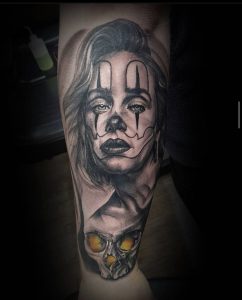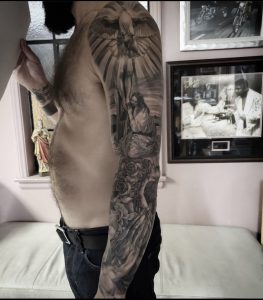Chicano Tattoos
While we remain homebound, we will continue to travel via our imagination – and through the ink on our skin. No matter how the world may wobble around us, that is one thing that can never be taken away once it is in place. This week, the turn has come to the US West Coast, Los Angeles, and Chicano tattoos and culture.
Self-determination

The word Chicano or Chicana comes from the term used to classify people of Mexican origin living in the United States. First, the name was used as an insult, but it was quickly appropriated and became the group’s chosen identity. Racism, classicism, and discrimination often forced the group to the fringes of society and the barrios with many Chicano men ending up in prison as a result of life in them.
In the spirit of taking what you have available to create art, people used what they could find in prison to create makeshift-style tattoo machines. They used these and the black and blue ink that they could get a hold of to tattoo each other. The motives drew inspiration from what the men knew, what they had experienced, and what they were missing while on the inside.
Chicano tattoo symbolism
In Chicano culture, tattoos were earned by members of the community. They often signify struggles that have somehow been overcome. The style itself is illustrative, working with black and grey tones and often plays on blending realism with surrealistic elements, as many prominent Mexican artists have done.
The symbolism in Chicano tattooing is very distinct. Payasas, sexy clown girls, are particularly prominent. Like many other symbols, it relates to the reality of gang-life in Los Angeles, referring to the blend of comedy and tragedy that life inevitably holds. These are often accompanied by the saying ‘Smile Now, Cry Later’.
Lettering is generally a big part of and incorporated into the motives. Lowriders, women, guns and money also all feature regularly. Themes of family, faith, struggle, hope and love are present throughout the style’s evolution.
There are also Virgin Marys, praying hands, sacred hearts and sugar skulls, all images related to Roman Catholic symbols and saints. While Mexico does not have an official religion, it is estimated that 80% of the population identify as Catholic and see it as part of their identity. It is passed down through the family as part of cultural tradition, and so it is no wonder it makes its way into tattoos closely linked to heritage.
Freddy Negrete and the growing appreciation for Chicano tattoos

One of the first artists to bring Chicano-style tattooing from the streets to the shops about 40 years ago was Freddy Negrete. An early member of the La Sangra gang, he left that life and has gone on to tattoo gang members and Hollywood personalities and sports stars. Freddy is now working out Mark Mahoney’s Shamrock Social Club on Sunset Boulevard.
While the style may have come out of a turbulent past, it has grown to be such a big part of West Coast culture that, while not exactly going mainstream, it is now recognised as a widely influential genre. Its beautiful artwork is becoming appreciated worldwide, and artists outside of the Chicano tradition are beginning to incorporate elements of the style into their pieces.
